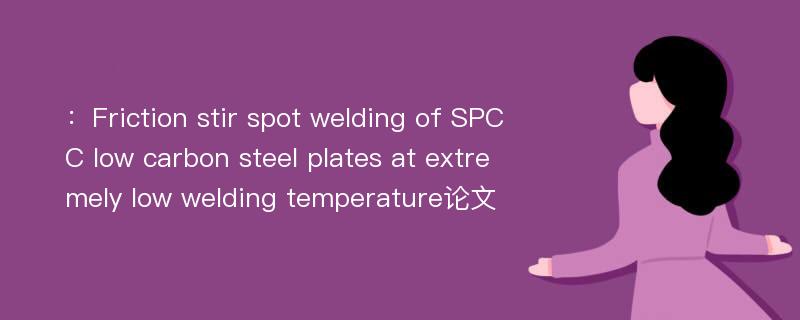
本文主要研究内容
作者(2019)在《Friction stir spot welding of SPCC low carbon steel plates at extremely low welding temperature》一文中研究指出:Friction stir spot welding(FSSW) was applied to 2.0 mm thick steel plate cold-rolled commercial(SPCC)low carbon steel plates at a very low rotation speed that ranged from 5 to 50 rpm, which was much lower than that generally used for the conventional FSSW technique. Due to the very low heat input, the welding processes could therefore be completed at a peak welding temperature below 160℃. As a result,a significantly refined microstructure with an average grain size of about 0.41 μm was formed in the stir zone of the joints and the J1{0–11}<-211> and J2{1–10}<-1–12> shear textures were the dominant components, which are different from the D1{11–2}<111> and D2{-1–12}<111> shear textures formed in the conventional FSSW joints. In addition, no heat affected zone could be detected along the crosssectional plane of the joints. Although a few void-like non-bonded areas were still observed along the interface between the upper and lower steel plates, the shear tensile loads of the joints increased to about 10.0 kN when welded at a condition of 8 t, 20 rpm and 30s, and the joints fractured through the plug failure mode.
Abstract
Friction stir spot welding(FSSW) was applied to 2.0 mm thick steel plate cold-rolled commercial(SPCC)low carbon steel plates at a very low rotation speed that ranged from 5 to 50 rpm, which was much lower than that generally used for the conventional FSSW technique. Due to the very low heat input, the welding processes could therefore be completed at a peak welding temperature below 160℃. As a result,a significantly refined microstructure with an average grain size of about 0.41 μm was formed in the stir zone of the joints and the J1{0–11}<-211> and J2{1–10}<-1–12> shear textures were the dominant components, which are different from the D1{11–2}<111> and D2{-1–12}<111> shear textures formed in the conventional FSSW joints. In addition, no heat affected zone could be detected along the crosssectional plane of the joints. Although a few void-like non-bonded areas were still observed along the interface between the upper and lower steel plates, the shear tensile loads of the joints increased to about 10.0 kN when welded at a condition of 8 t, 20 rpm and 30s, and the joints fractured through the plug failure mode.
论文参考文献
论文详细介绍
论文作者分别是来自Journal of Materials Science & Technology的,发表于刊物Journal of Materials Science & Technology2019年05期论文,是一篇关于,Journal of Materials Science & Technology2019年05期论文的文章。本文可供学术参考使用,各位学者可以免费参考阅读下载,文章观点不代表本站观点,资料来自Journal of Materials Science & Technology2019年05期论文网站,若本站收录的文献无意侵犯了您的著作版权,请联系我们删除。
